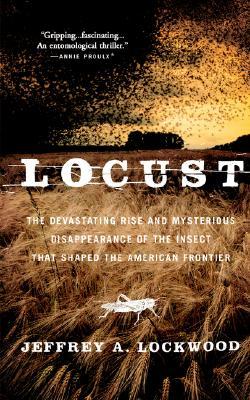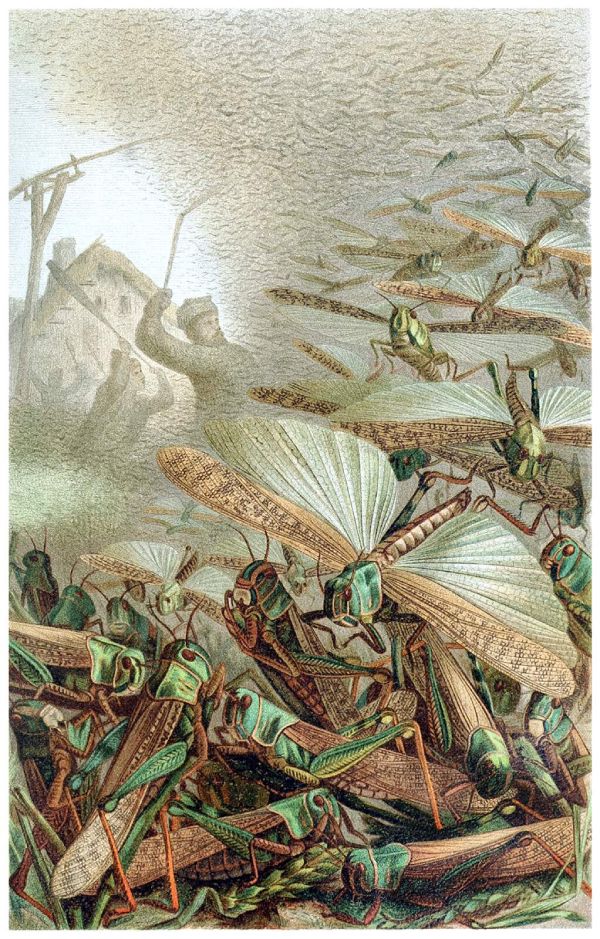Early white settlers on the high plains of the western U.S. were always bummed out when colossal swarms of locusts dropped by for lunch. The sky would darken, and the land would be filled with the roaring buzz of millions of fluttering wings. Within an hour or so, everything was covered with them, including the settlers, who frantically tried to brush off the hundreds of hungry insects that were chewing apart their clothing.
They were Rocky Mountain locusts, a North American species that lived west of the Mississippi — and the stars of Jeffrey Lockwood’s book, Locust. When swarming, these insects were a horror show. A swarm could devour 50 tons of greenery in a day. Trains couldn’t move because the tracks were too greasy. Swarms were like tornadoes, wiping out one area while leaving other neighbors in the region untouched.
In June of 1875, folks in Nebraska observed a swarm that was 1,800 miles long (2,900 km), 110 miles wide (177 km), and between a quarter and a half mile deep (0.4 to 0.8 km). It devoured 198,000 square miles (512,000 sq. km), an area almost as large as Colorado and Wyoming. The swarm took five days to pass. Lockwood estimated that it might have been 10 billion locusts — possibly the biggest assemblage of animals ever experienced by human beings.
Normally, maybe 80 percent of the time, locusts stayed in their home base, in the river valleys of the northern Rockies, a habitat that may have consisted of a mere 2,000 acres (809 ha). They ate, reproduced, and enjoyed life.
Periodic droughts would reduce the available food supply, causing locusts to crowd into pockets of surviving greenery. Dry weather eliminated the population control provided by fungal diseases. Drought also concentrated the nutritional value of vegetation. Warmer temperatures meant that locusts grew to maturity more quickly, so they spent less time in the nymph stage, when predators took a heavy toll on the helpless youngsters. The swarming process was triggered by crowding. They could either starve or see the world.
A hungry swarm of two million American settlers moved into the high plains in the 1870s, and ravaged the short grass prairie with cows and plows. They planted lots of wheat, and then discovered that locusts preferred wheat to everything else on the menu.
They exterminated the bison that were perfectly adapted to the ecosystem, and brought in cattle that were unsuited for the arid climate, did not fancy the native vegetation, and died like flies during frigid winters. They exterminated the wolves, and other wild predators, because they enjoyed owning and exploiting helpless dimwitted domesticated herbivores.
Settlers attempted to import their Western European way of life to an ecosystem where it could not possibly thrive. Instead of trying to adapt to the ecosystem, they expected the ecosystem to adapt to their exotic fantasies — a traditional recipe for failure. In their dream world, locusts were pests, wolves were pests, bison were pests — death to all pests! 
The Indians perceived locusts, wolves, and bison as being sacred relatives, not pests. The Indians enjoyed a time-proven culture that was well adapted to the ecosystem. Can you guess who the Indians considered to be pests?
Long ago, in the wilderness of Judea, there was a holy roller named John. One day, he baptized a lad called Jesus. The heavens opened up, a spirit appeared, and led Jesus away to the wilderness for a life changing 40 day vision quest. The Baptist had a wild diet: “And the same John had his raiment of camel's hair, and a leathern girdle about his loins; and his meat was locusts and wild honey.” (Matthew 3:4)
To the Indians, locusts were not pests, they were a sacred source of nutritious food. Their tasty flesh was rich with calories and 60 percent protein. In an hour, they could forage 200 pounds(90 kg) of dried insects, storing away 273,000 calories. It was faster, easier, and safer than hunting large, strong, speedy herbivores with sharp horns that took great pleasure in trampling and disemboweling hunters.
At the Great Salt Lake, Mormons discovered that locusts couldn’t swim. Millions would drown, and then the winds would push their bodies to the shore, in piles six feet high (1.8 m) and two miles long (3.2 km). As the corpses rotted, memorable fragrances wafted on the air. While a tremendous source of excellent food rotted away, the settlers complained about the stink.
White settlers loathed the locusts. Comically, everything they tried to exterminate the swarms failed — flooding, rollers, dynamite, trawlers, poisons, flamethrowers. During the swarming phase, resistance was futile, the insects were impossible to control.
Eventually, entomologists were summoned to combat the insects with science. Several chapters shine spotlights on famous entomologists who strove to understand locusts, and render them harmless to the devastating swarms of white settlers.
As more settlers moved into the high plains, the locust numbers declined. There were fewer swarms. Attention shifted to other challenges. Eventually, entomologists realized that nobody had seen a locust in a long time. The last Rocky Mountain locust died in Manitoba in 1902. They went extinct, but folks didn’t notice for quite a while. It was unimaginable that critters that existed in such enormous numbers could completely disappear within a few decades.
A number of half-baked theories attempted to explain the spooky extinction, but Lockwood was the one who finally solved the mystery. He visited several “grasshopper glaciers” where layers of dead locusts could be observed, and found locusts that died 800 years ago. Swarming was not caused by settlers.
One day, he had an insight. Monarch butterflies are vulnerable to extinction because the forests where they spend the winter are being eliminated, and this is a bottleneck. The bottleneck for the locusts was their home base along northern river valleys — arable lands, exactly where whites preferred to settle. Irrigation, tilling, and cattle grazing hammered the locusts where they were most vulnerable, home sweet home.
Entomologists around the world work tirelessly to discover new methods for exterminating agricultural pest species, and the insects always succeed in outwitting the wizards. The Rocky Mountain locust is the one and only major insect pest to be completely wiped out, and they were driven to extinction unintentionally.
They were only “pests” in the eyes of the civilized. Prior to white settlement, there were no plowmen, ranchers, pests, or entomologists, just a wild ecosystem living in its traditional manner. Maybe entomologists should help us exorcist the pests in our nightmare worldview, teach us how to live in balance, and call an end to the futile poisonous war on our insect relatives.
Lockwood mused that crowding also inspires bizarre behavior in humans. We have powerful urges to escape from the neurotic mob, and fly away to places of refuge, to pure unspoiled suburban utopias.
He noted that while locust populations sometimes soared to enormous peaks, vast numbers did not guarantee long-term survival. He noted that the human population is currently at an enormous peak. Both humans and locusts are generalists that can migrate and adapt. Locusts dined on at least 50 varieties of plants. Humans, on the other hand, largely depend on three plants: rice, wheat, and corn. Will climate change be our bottleneck?
Lockwood, Jeffrey A., Locust, Basic Books, New York, 2004.
A 2:22 minute video of a minor locust swarm in Madagascar is here.
Lockwood’s condensed version of his locust story is here.





